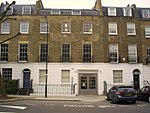York & Albany
GastropubsGrade II listed buildings in the London Borough of CamdenGrade II listed pubs in LondonHotels in LondonLondon stubs ... and 2 more
Pub stubsPubs in London

The York & Albany is a former pub in Camden Town, London, near Regent's Park. The building is part of a development by John Nash, and is Grade II listed. It was at one time operated by Gordon Ramsay as a boutique hotel and gastropub. The gastropub was positively reviewed by restaurant critics. During that period, the validity of the lease was disputed by Ramsay, leading to a legal dispute. The pub closed in March 2024. In April 2024, the building was occuptied by squatters.
Excerpt from the Wikipedia article York & Albany (License: CC BY-SA 3.0, Authors, Images).York & Albany
Park Village East, London Chalk Farm (London Borough of Camden)
Geographical coordinates (GPS) Address Nearby Places Show on map
Geographical coordinates (GPS)
| Latitude | Longitude |
|---|---|
| N 51.536 ° | E -0.1464 ° |
Address
York & Albany
Park Village East
NW1 7PX London, Chalk Farm (London Borough of Camden)
England, United Kingdom
Open on Google Maps










